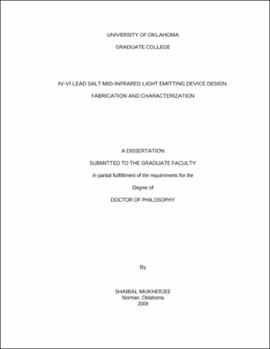| dc.contributor.advisor | Shi, Zhisheng | |
| dc.creator | Mukherjee, Shaibal | |
| dc.date.accessioned | 2019-04-27T21:32:34Z | |
| dc.date.available | 2019-04-27T21:32:34Z | |
| dc.date.issued | 2009 | |
| dc.identifier | 99280626302042 | |
| dc.identifier.uri | https://hdl.handle.net/11244/318958 | |
| dc.description.abstract | The research detailed by this dissertation has demonstrated the design, fabrication, and characterization of lead salt semiconductor mid-infrared light emitting devices. A scrupulous theoretical model has been described which estimates spectral gain from the quantum well (QW) structure based on IV-VI lead salt semiconductor material. The spectral gain of the QW structure, with both for finite and infinite well, for different crystal growth orientations is detailed. The purpose was to determine the best lead salt crystal orientation to fabricate opto-electronic devices. | |
| dc.description.abstract | Detailed experimental works concerning recent developments of IV-VI lead salt light emitting devices have been demonstrated. An electrically excited QW laser on [110] oriented lead salt substrate is reported for the first time in the literature. A brief description on the fabrications and characterizations of novel microstructures in the form of rod, tube and pillar, having enormous applications in MEMS and NEMS, is provided. | |
| dc.description.abstract | A theoretical exploration of spontaneous mid-infrared emission from IV-VI semiconductor photonic crystal defect microcavity is elaborated. The design is aimed to solve out challenges of the formation of resonating cavity for lead salt materials fabricated on Si(111) or BaF2(111) substrates, commonly implemented to fabricate high temperature, continuous wave (CW) lasing devices. The band structure calculations of the periodic crystal are performed using plane wave expansion (PWE) method. Finite difference (FD) perturbation correction method and finite difference time domain (FDTD) algorithms have been employed to analyze modal field distribution in the defect cavity. | |
| dc.description.abstract | A study on the measurement of minority carrier lifetime, which is one of the very important figures of merit to judge opto-electronic device performance, is illustrated. Photoconductive decay (PCD) method, a very popular and well-established methodology has been adopted to carry out the experimental work. The implementation of CaF2 as a new surface passivation layer for MBE-grown PbSe single crystalline thin films on a BaF2(111) substrate has been done and the corresponding effect on device performance is compared. Minority carrier lifetimes and pulsed photoluminescence intensities from PbSe samples are observed to increase after CaF2 surface passivation. However, the improvement is comparatively more significant at low temperature than at high temperature. This may indicate that surface passivation for Pb-salt materials are not as critical as its II-VI and III-V counterparts at high temperature of device operation. Therefore, device fabrication for Pb-salt materials at elevated temperature could be relatively more cost-effective with a higher-yield. | |
| dc.format.extent | 181 pages | |
| dc.format.medium | application.pdf | |
| dc.language | en_US | |
| dc.relation.requires | Adobe Acrobat Reader | |
| dc.subject | Solid-state lasers | |
| dc.subject | Quantum wells | |
| dc.subject | Semiconductors | |
| dc.title | IV-VI LEAD SALT MID-INFRARED LIGHT EMITTING DEVICE DESIGN, FABRICATION AND CHARACTERIZATIONIV-VI LEAD SALT MID-INFRARED LIGHT EMITTING DEVICE DESIGN, FABRICATION AND CHARACTERIZATION | |
| dc.type | text | |
| dc.type | document | |
| dc.thesis.degree | Ph.D. | |
| ou.group | College of Engineering::School of Electrical and Computer Engineering | |
